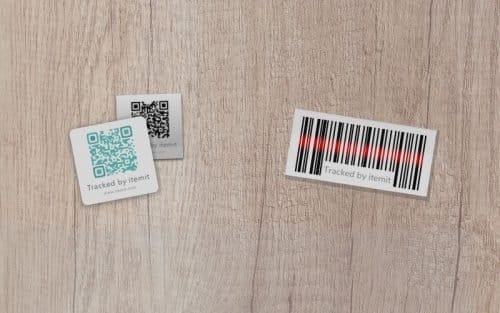Implementing asset tracking software in your business can feel like a huge task. There are a lot of things to take into account when you’re searching for an asset tracking system.
Once you’ve ironed out what you’re looking for, however, you’ll benefit from the tools and functionality that asset tracking systems can assist you with.
Instead of needing to change a spreadsheet manually, an asset tracking app allows you to log changes on an asset level while you have the asset in front of you. This gives you much more control and accountability over your assets instantly.
Therefore, when you use asset tracking software, you will:
- Lose fewer assets
- Save time on operations
- Save money on asset retrieval
- Maintain an accurate fixed asset register
- Improve your accountability over assets
- Automate your operations
- Improve maintenance operations
- Keep a clear view of who is responsible for what
- And more!

Using Asset Tags
Asset tags unlock a lot of functionality. When you use asset tags, you’ll be able to take your asset tracking app’s capabilities further. Depending on which tags you’re using, you’ll be able to create different levels of automation over your asset list.
The way asset tags work is by linking unique assets to their digital profiles. In other words, if you’ve tagged an asset with a QR code, you will be able to find that asset in your asset tracking app simply by scanning the tag.
Barcode Asset Tags
Barcode asset tags are most commonly used when it comes to tracking assets. This is as they’re easy to use, easy to implement, and effective.
A potential issue with barcode asset tags, however, is that they may not be unique. This is as a lot of barcodes contain pricing information. To ensure that you can retrieve unique asset profiles, the corresponding tags themselves must be unique too.
QR Code Asset Management
QR code asset tags work in much the same way as barcodes. Much like barcodes, too, you’ll be able to use custom QR codes. This means that if you’re tracking heavy tools and equipment, you’ll be able to use metal QR code asset tags to ensure that weathering doesn’t affect the tag’s readability.
Whenever you scan a QR code or barcode in your asset tracking app, the asset’s last seen location will be updated, as well as the user who scanned the tag and when they scanned it. This uses your phone’s GPS data and creates a neat audit trail.
You can track interactions with your assets this way. For example, if you wish to report an issue on an asset, all you need to do is scan the asset’s tag to open its profile and press “report issue”. As you’ve scanned the tag, this interaction will be logged on the system, giving your maintenance team everything they need to know to fix the asset quickly.

RFID Asset Tracking
RFID asset tracking unlocks more speed when it comes to maintaining your asset register. This is as RFID tags use radio frequencies to be detected, so they can be scanned from a distance.
The main difference between RFID tags and QR codes is that you’ll be able to scan QR codes using your phone’s camera, where RFID tags will require third-party hardware to be read.
Therefore, if you need to audit a group of assets within a room, when you’re using a handheld RFID system, it’s a simple process of clicking “audit” and holding down the trigger on your handheld RFID reader.
Separate from handheld RFID systems, you’ll also be able to implement fixed RFID asset tracking. Fixed RFID asset tracking automates your operations even further, and is well-suited to busy environments, such as with healthcare asset management.
Fixed RFID readers can pick up whenever an asset moves from one location to another, meaning that you can log any changes (such as one shelf to another) on your asset tracking software without the need for manual input.
The other edge that RFID tags have over QR codes and barcodes is that you can conceal RFID tags while keeping them readable. This means that you can use RFID tags for high-value collection tracking, as you can conceal RFID tags under a painting’s frame, for example, so as to not affect the value of the asset itself.
GPS Trackers
GPS trackers fill in any gaps when it comes to location tracking. When you use QR codes, barcodes, or RFID labels, you can only track an assets’ location whenever an interaction occurs. This would otherwise mean that if an asset leaves one of your sites, the risk of losing accountability or visibility over it would increase exponentially.
GPS asset tracking fixes this as you’re able to attach GPS trackers to your assets for when they’d otherwise lose visibility. GPS trackers update periodically and tell your asset tracking software where your assets are. This is helpful in ensuring that deliveries go to the right place, but is also used across large distances on sites.
For example, if you’re tracking assets on an airfield, you’ll be able to use GPS trackers to see how your assets are moving without needing to manually interact with your tools or equipment.
Asset Tracking Software Functionality
The best software gives you the ability to use a cloud-based asset management system with an integrated app and web portal. This allows you to mix and match functionalities depending on if you’re onsite with assets, or if you’re running reports offsite.
You can also speed up your operations further by sharing your asset tracking software with your colleagues. Many departments within a company can use the same asset tracking software to achieve different things depending on their specific needs and responsibilities.
This way, your maintenance team can log issues and run maintenance on assets onsite and log it on your system while your administrators monitor this, and your finance team can run concurrent reports and complete fixed asset management operations on their end.
This is why a cloud-based system is highly effective as it allows you to change asset data onsite, with assets, at speed, but you’re also able to monitor and update this data remotely.
Features are of the utmost importance here, as these will be how you spread your asset management efforts across your business. If one person is able to use the system as equipment checkout software, while another can track issues and maintenance, such as PAT tests, while another can run reports on asset depreciation, then you’re able to get the best ROI possible.
At the core of your asset tracking software, there must be a way to add unique assets and add unique information and data, such as images, attachments, purchase prices, against them, but you also must be able to build on this by making use of a range of effective, time-saving, and helpful features.
Industries That Can Use Asset Management Software
So, which industries can asset management software help? The short answer is any business that doesn’t have an effective way of tracking assets can use software to speed things along. For example, immediately when you log your assets onto your system, you get a robust fixed asset register, which is instantly helpful in mitigating ghost and zombie assets for tax and insurance purposes.
However, asset tracking efforts can be split into two main subsections, tools and equipment tracking and IT asset management. These can overlap, such as with school asset management as both types of asset will need to be logged on a school asset register, but generally, businesses are looking for equipment management, IT asset management, or fixed asset tracking which is a combination of both.
Tools And Equipment Tracking
One angle you may be looking from is tools and equipment tracking. This is helpful for construction equipment tracking or healthcare asset tracking, for example, as there are more pre-emptive and reactive maintenance needs than with IT asset management.
Therefore, you’ll be able to find an asset tracking software that allows you to log your tools and equipment and track specific maintenance, usage, and location data.
When it comes to tracking tools, too, you may need to track rentals. This is why your asset tracking software should have effective bookings and check in check out system.
Your assets may span a larger location than if you’re tracking IT assets, too, which is why effective location tracking is essential. This should also be put in place to mitigate theft on construction sites.
IT Asset Management
IT asset management may present different needs than when you’re tracking your tools and equipment. While still applicable in the context of construction sites, IT asset management software capabilities are more required in offices, in councils, and, potentially, when it comes to charity asset tracking.
IT asset management is especially prevalent now as around 46.6% of the UK workforce started working from home in 2020. This is why it’s essential to have effective features which show who is responsible for your assets.
Asset tracking software allows you to track IT assets better and monitor them wherever you are in the world, allowing for an effective way to maintain your accountability over assets when it would otherwise be lost by shifts to and from a workplace.
Fixed Asset Tracking
These two efforts are then combined into fixed asset tracking. Your fixed assets are permanent fixtures in your asset register that aren’t sold as stock. This can be anything from your laptops to your furniture to your tools and equipment.
All companies across all industries, including theatres tracking assets, restoration companies, schools, and charities, must track their fixed assets.
Without an up to date fixed asset register, there is a risk that tax breaks aren’t achieved or are inaccurate, as well as a risk that your accounts are incorrect, as fixed assets count as business expenses.
Therefore, when you’re choosing an asset tracking software, one that will have the capabilities to track fixed assets and, as an extension, tools, equipment, and IT assets is a must.
Having an effective reporting system will allow you to keep these efforts separate, or combine them depending on what you’re reporting on. Therefore, you need a system that allows you to filter by any field on an asset level, meaning you can export fixed asset registers, IT asset registers, and equipment asset registers quickly and separately.
Setting Up Your Asset Tracking Software
The final step is knowing the best way to set up your asset tracking software. There are a few ways of going about doing this, depending on your preference or working arrangements.
Firstly, though, you should go for an asset tracking software that allows you to commence a 14-day free trial. This way you will be able to field test your software against your specific use case at no cost, ensuring your software will work for you.
When you’ve decided, the next steps will be to consider how to add your assets. If you have an existing asset register, such as one on a spreadsheet, this will be importable onto your system. If not, a cloning or templating system will speed up asset creation if you have many similar assets.
One way of setting up your asset tracking software is by auditing assets by creating them in your system while you’re tagging them. This way, you’ll have the asset in front of you when you log it onto your system and will even be able to take a photo of it. Then, you can tag the asset.
Once an asset has been logged and tagged, you can start to add any information to it, such as which location it’s supposed to be in, who is responsible for the asset, or when maintenance is due on it.
At the end of this process, you’ll be able to run a report to ensure that all of your assets are tagged and seen. After this, your asset tracking operations will start to take care of themselves!
To find out more about how you can use itemit’s asset tracking software, you’ll be able to contact us at team@itemit.com. You can book a demo here to see the system in full swing, and you can also start your very own 14-day free trial by filling in the form below.

Try itemit
Choose a better way to track
your assets.
Start your free 14-day trial now!

Keep Learning
itemit Blog
Tips, guides, industry best practices, and news.
Why Your Library Needs Asset Tracking Software
Your library needs a tracking system so you know where your inventory is all of the time. Discover why an RFID asset tracking system is ideal!
How To Switch To Asset Tracking Software
Have more than a few assets and want to have more control over them? Read this post to find out how asset tracking software can help!
Tool Maintenance Made Easy
Would you like to keep your tools in a better condition? read this post now to find out how using pre-emptive maintenance can help!

